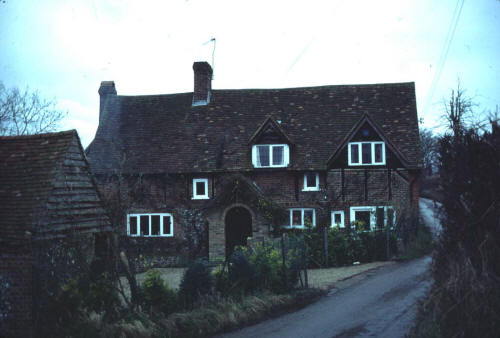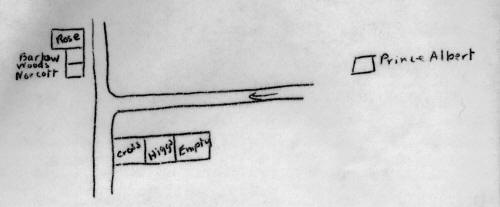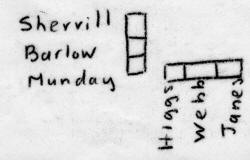Your House and Mine |
Perrin Springs |
|||||||||||||||||||||||||||||||||||||||||||||||||||||||||||||||
|
Introduction
Map of Frieth Moor End Bramblings Astrea Merrydown Cottage Corner Cottage Moor's End Cottages Moor Gate House Underwood The Copse Fingest Road The Forge Folly Cottages The Willows Perrin Springs Lane Perrin Springs West's Cottages Ellery Rise Hilliers Lynden Cottage Frieth Hill Hillside Cottage Rowleys Pear Tree Cottage Hillside View The Platt Little Barlows Cutlers Cottage Yew Tree Cottage Little Cottage Barlows Birch Cottage Tedders / Rose Cottage The Old Stores The Yew Tree Inn Fairfield House Flint Cottage 1 Flint Cottage 2 Inglenook Middle Cottage Sunny Corner The Gables The Orchards Hilltop Cattons Mallards Hillswood The Old Parsonage White Gates The Laurels The Cottage The Firm Marlstone Westwood Bradstone Haylescroft The Niche Rivendell Summerhill Ashcroft Selborne The Ranch House Sara's Cottage The Cherries The Old School House Innings Road Collier's Farm Innings Gate Down the Lane Sunset Cottage Fermain Chilterns Rowan Cottage Creighton Cottage Apple Tree Old Well Cottage The Cottage Flat Roof Whitsun Backlins Red Kites Maidenscraft Spurgrove Lane Maidencraft Cottage September Cottage Spurgrove Cottage Gable End Willems Elder Barn Sunnydale |
Perrin's Spring, Perrin Spring or Perry Spring, variously called, is the name of the spring at the side of the road opposite the Prince Albert. The name Perry etc probably comes from two words 'per' meaning clear, pure [in Celtic] and the 'y' from ēa [Old English] meaning stream or water. At the top of that lane on the left hand side is one of Frieth's oldest houses
The earliest written reference to this house, found so far, is amongst the Deane Papers held in the PRO at Aylesbury [Centre for Buckinghamshire Studies ] and dated 1648 when the property changed hands. The purchaser was William Walker who had been a tenant. He paid £120 for it. The Walker family can be traced further back in the Hambleden Parish registers ( also in the PRO at Aylesbury ). In 1648 Perrin Springs was a farmhouse called Elleryes and the land on either side of the lane from there to Frieth Hill and bounded to the east by Moor Common belonged to this farm holding . When, in the Victorian era, a new farmhouse, Hilliers, was built at the opposite end of this farm holding, Elleryes was let as three cottages for farm workers. Since WW2 these were sold as one holding and reconverted into one house. [ The above text appeared in the "Your House and Mine"
folder but a more detailed document has emerged from the files, apparently prepared for the
owners in 1985. The Site This property is a good example of a dwelling being sited close to a natural water supply; the spring and streamlet below the house and to the east of it. A clear explanation of the geological features of the Lane End, Moor Common, Frieth area is given in 'Memoirs of the Geological Survey of England and Wales, explanation of sheet 254. The geology of the country around Henley-on-Thames' by Jukes Burke and Osborne White H.S. Office 1908 pp64-67 This article describes the faults which produced a line of springs across Frieth Hill (now under a manhole cover), never known to run dry and still in use until 1934 when piped water came to the village, and Perrin Spring between this property and the Prince Albert. The meadow between these two springs is also wet in places and a small stream runs along its lower side. This stream may have been larger at one time - before the Water Board Authority had soakaways dug in this area. As late as 1960 there was still a channel down the right hand side of Frieth Hill to take surface water. In early historical times it would have been a pleasant surprise for people to come across a stream and springs on what was a dry plateau area of the Chilterns - thus an ideal spot for early habitation. The site on which your house stands may have been inhabited from very early times. The name Your property has been called by variations on the name i.e. Perry Spring, Perrin Spring, Perrin's Spring, Perrin Springs, Perring Spring, Perring Springs, Perring's Spring. There is little written evidence of its origin. 1. Jeffery's Map 1770 does not name this area 2. Bryant's Map 1825 gives Perry Spring 3. Ordnance Survey Sheet 71 revised c1850 gives Perrins Spring 4. Mawer and Stenton in 'Place Names of Buckinghamshire 1925, do not mention it 5. A,H, Stanton on 'On Chiltern Slopes' p42 & 43 says of the Coventry family memorials in Hambleden Church : "There are two slate slabs on the floor opposite the main door commemorating members of this family; also one of Thomas Perry 1724 buried here by his niece Gratia Maria Coventrye, who was herself buried in 1724. We may suppose that the name of Perry's Spring at Frieth has some connection with him or his family. They probably owned land about the spot. There is also a slab near there with the name Elizabeth Hall, niece of Thomas Perry (of Turville) buried here." I don't know where Stanton got his 'supposition' from, but (so far) I have found nothing to substantiate it - if [the deeds] go back that far and include the name Perry that will solve the mystery! Failing that my explanation [for the derivation is as given above in the main text ] Ellery Rise is named after Ellery Wood. Ellery Wood grew around and on the slope above the little stream mentioned earlier. I believe Ellery comes also from a fusion of words : eller O.E meaning alder tree ēa O.E stream, water as above ellery - the stream where the alder trees grow The name Hilliers comes from the same root. Hilliers was called Hilary Farm in the 1920s when owned by a family named Ellis who moved down from Ealing. Doubtless they (or their solicitor) assumed that the 'locals' who called it Illery Farm had dropped the 'h' Illery (farmhouse) or Illerys was built in 1854 as the new farmhouse of Illerys / Ellerys farm to supersede yours, which then became the farm cottages. West Cottages (I've never delved into when they were built or by whom) were farm cottages too. [ See West's Cottages for more information] The first mention of the name Ellery that I have found comes in a bundle of deeds at the PRO in Aylesbury and is contained in 'Deeds deposited by Mrs J F Knight of Little Colstrope Hambleden, together with the deeds of Colstrope farm' listed as 'Feoffment Clarke to Walker : cottage called Ellereyes and land at Frieth in Hambleden 24 June 1648' I am sure you will want to see this parchment for yourselves. I merely scanned it and did not translate it word for word. However the essence is : 24 June 1648 Indenture ... between John Clarke of Hitcham Bucks and William Walker of Hambleden William Walker paid £120 to John Clarke for "that cottage or tenement where William Walker now dwelleth commonly called or known by the name of Ellereyes, and also all those four closes of arable lands and wood grounds lying altogether - - - adjoyinge to the said cottage or tenement (on both sides of the lane) there conteyninge in all by estimacon Tenn acres bee they more or lesse. And also all that coppice or wood ground being next adjoyning to the said closes contayninge by estimacon ffoure acres bee yt more or lesse; All - - - premisses are situate lyinge and beinge att the ffreeeth in the parishe of hambleden aforesaid in the county of Bucks and now are in the - - - occupacon of the said William Walker" (Later - - - John Clarke's wife was Philadelpha - his attorney was William Davenport of Chepinge Wicombe ) Witnesses - Thomas Falconer, William Harrington, William Walker, William Messinger There are two other papers worth examining at the PRO listed in the same collection (Deane papers) - I have not examined either of them : 'Miscellaneous estate papers including sale agreement (Walker and Tyrell) concerning messuage and land in Hambleden 1764' 'Piece of arable and woodland in Fingest Walker family settlement 5 June 1683' The land Having compared the acreage, position etc. of the 1648 deed with the Ordnance Survey 1/2500 map of the area dated 1921 I'm sure we have the same farm - the extra acreage might be accounted for by the proximity of the lower field to the common ground owned by the Lord of the Manor of Hambleden, an encroachment of 15 yards at the bottom of the slope taken across the field would add another acre between 1648 and 1921! The Tithe Map of 1845 gives a similar farm plan but unfortunately omits all the acreages. The people The 1841 Census return gives the name Perrin Spring and lists 3 families. The name Perrin Spring refers to the area, so which family lived in the farmhouse and which in West's Cottages is unclear. The families were :
The Tithe Map and Schedule 1845 gives : Barnaby Finch - owner Thomas Deane - tenant Neither of these appear in the 1841 or 1851 census return for Frieth - in fact Thomas Dean(e) appears again in the schedule as owning property elsewhere in Hambleden Parish. The 1851 and 1861 Census Return does not mention the district Perrin Spring separately but, from the number of households, attaches it to Spurgrove. However the Cope family appear, and James Cope styles himself as 'farmer of 9 acres', he now has 3 sons as well as 3 daughters : John James 9, Daniel 7 and Robert 5. The 1861 census also gives : StephenTaplin 55 Farmer of 15 acres Sophia Taplin 54 living at Great Frieth i.e. in the new 'Hilliers' farmhouse. The 1871 census Return calls your area Perrin's Spring but the enumerator appears to have got in a muddle about 'who is who', their surnames and kith and kin! It seems there were 5 or 4 living units here with 1 empty cottage (or did the Higgs family overflow into it!)
It would appear that West's Cottages were 2 or 3 living units at this date and certainly by the 1890s ( See Mr Ted Collier's map on the cover of 'Frieth a Chiltern Village') The Tithe Map of 1845 appears to give two cottages and a barn / outhouse / farm building. The cottage Miss Hall lives in now (1985) was two until recently so the cottage next door was of later date than hers. None of this establishes which families lived in yours in 1871 but the enumerator had come up the lane from the Prince Albert so my guess is :
[ Of course coming from the Prince Albert may have had an impact on his accuracy ! ] From 1871 - 1949 a succession of tenants must have occupied these cottages - the 1881 Census returns are published now - but I have not seen them yet. Mr Ted Collier gives :
Your deeds should supply much of the rest. During the late 1920s and 1930s Mr Ernest Fielder took the lower of the three cottages as a weekend cottage and it was he who had it panelled with dark (oak?) wood. In the 1930s and 40s George Leaver lived in the cottage at the other end by the corner. He was brother-in-law to Emma Keep who kept the 'Yew Tree'. George was living there during the war and, as he heard the drone of our planes in the late evening going out he would say "Ah, they be upender agin ternight' (So I've been told!) The Fielders were followed by Miss Pope and her friend Miss (?) who I understand bought the smallholding, or most of it - a relative still owns the lower field (rented by Mr Tom Nixey) After the war the property appears to have been fragmented again. Mr Nixey (senior) owned some of it for a short while. A study of your deeds and Foster's should sort it all out. Summary Your house Perrin Spring was the farmhouse of a smallholding called 'Elleryes' in 1648. The smallholding changed hands several times between 1648 and 1845 but probably remained intact until then. Barnaby Finch may have bought it for its woodland/coppice. By 1861 Mr Taplin appears to have owned the whole smallholding again. The smallholding was fragmented again after WW2 when the Council Houses were built. Joan Barksfield 1985 |



